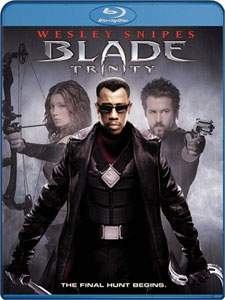“Blade: Trinity” (2004) gives Blade (Wesley Snipes) some friends, and what a great decision that is. Blade retains his badass loner persona, but now Ryan Reynolds is in the mix, laying down one-liners like he’s auditioning for Deadpool, and a buff and sexy Jessica Biel also signs up.
David S. Goyer, the ubiquitous (some say too much so) superhero film writer who also penned the first two installments, adds director duties here and pares “Blade” down to its essentials. The wonderfully staged action sequences, snort-worthy quips and game performances combine to make this the best of the trilogy.
A more basic plot
There’s not a lot to say about the plot, which is actually a good thing because “Blade” (1998) and “Blade II” (2002) are unnecessarily convoluted. In “Blade Trinity,” a group of vampires – including Danica (Parker Posey, whose Parker Poseyness is another nice treat in this movie) – digs up Dracula, a.k.a. Drake (“Prison Break’s” Dominic Purcell), from a tomb in Syria so he can lead them to victory over the pesky humans.

“Blade: Trinity” (2004)
Director: David S. Goyer
Writers: David S. Goyer, Marv Wolfman, Gene Colan
Stars: Wesley Snipes, Kris Kristofferson, Parker Posey
Whistler (Kris Kristofferson) – who has outlived his time as the wise mentor archetype – goes out in badass fashion. “Don’t move a finger,” instructs a federal agent, who is tracking down Whistler and Blade after Blade killed a human. “How about this one?” Whistler responds, extending his middle digit before an explosion.
If you like that kind of writing, “Trinity” has a lot of it, and most of it connects. Reynolds – who would later play Deadpool and Green Lantern – knows how to deliver this material, unleashing a steady stream of jokes and situational commentary. As vampire hunter Hannibal King, his reaction to the vampire dogs mirrors that of the audience: “What the f***?!” But unlike with the “Deadpools,” “Trinity” stays enough on the serious side to not be an outright comedy.
As Abigail, the secret daughter of Whistler, Biel transforms herself into an action star; her movements when doing martial arts or shooting arrows is natural. If there’s a lot of work by a stunt double, the film hides it well.
Reynolds and Biel don’t steal the show from Snipes, but they take enough weight off his shoulders that we’re back to the pure enjoyment of watching Blade do his thing. There’s no lag time here where Blade broods about being an unappreciated outlaw. He is still that, certainly, but “Trinity” doesn’t rub our faces in it. It gets to the next action sequence.
Clever action
My favorite action moment comes when Blade throws his boomerang scythe through a line of advancing vampires, jumps up to the catwalk above and catches it on its return, after it has cut down dozens of vamps.

“Trinity” continues with the vampire mouth designs from Guillermo del Toro’s “Blade II” – and expands them to canines – and the city (still unnamed) is often dark but we can still tell what’s going on by the skyscraper window lights. In the daytime – as Drake and Blade are both daywalkers — a gripping chase scene goes through an apartment building, but not in ordinary fashion, because walls and open spaces do not slow these two down. A tip of the cap goes to Goyer and his editors for making this sequence comprehensible, let alone fun.
These action sequences are creative enough that I forgive a couple of ripoffs/homages. Abby gives a “bring it on” gesture that’s straight out of “The Matrix”; this has to be on purpose. And Hannibal drops a cross into a building’s sprinkler system in order to douse vampires with holy water; Buffy uses this method (with a priest instead of a cross) in the comic arc “Viva Las Buffy!” This is less likely to be a purposeful ripoff, and it’s quite possible other vampire hunters used this trick before Buffy.
Goyer is less interested this time in expanding the mythology of the “Blade” universe, but the film is not devoid of a bigger picture. It shows us the first vampire, Dracula, as well as human society’s first knowledge of vampires.
Welcome new friends
After Blade mistakenly kills a human, the police – led by James Remar’s Cumberland — are on his tail. But rather than going over well-trod territory (not that Blade is going to turn to the dark side like “Buffy’s” Faith; he has already found a sweet spot as an antihero), Goyer introduces new friends when Blade needs them most.
It makes sense that there would be other cells of vampire hunters out there. Then, dodging the muddy territory of vampire hunters having to fend off human cops, we see that vampires have infiltrated the police and military. Convenient? Yes, but it’s also logical.
My quibbles are these. There’s evocative rundown architecture in the film, but the action is too propulsive to dwell on it; I would’ve liked slightly more breathing room and style. The music, as with the first two films, is either rap-rock about death and violence or generic computer strains, like an option in video-making software. I got used to it, but I prefer orchestral scores.
Everything else is pretty darn great, presenting a case that Goyer does not deserve to be Public Enemy No. 1 among superhero fans. “Blade: Trinity” shows that when Goyer is directing his own writing, he can deliver a tight, dark, humorous and fun romp.

